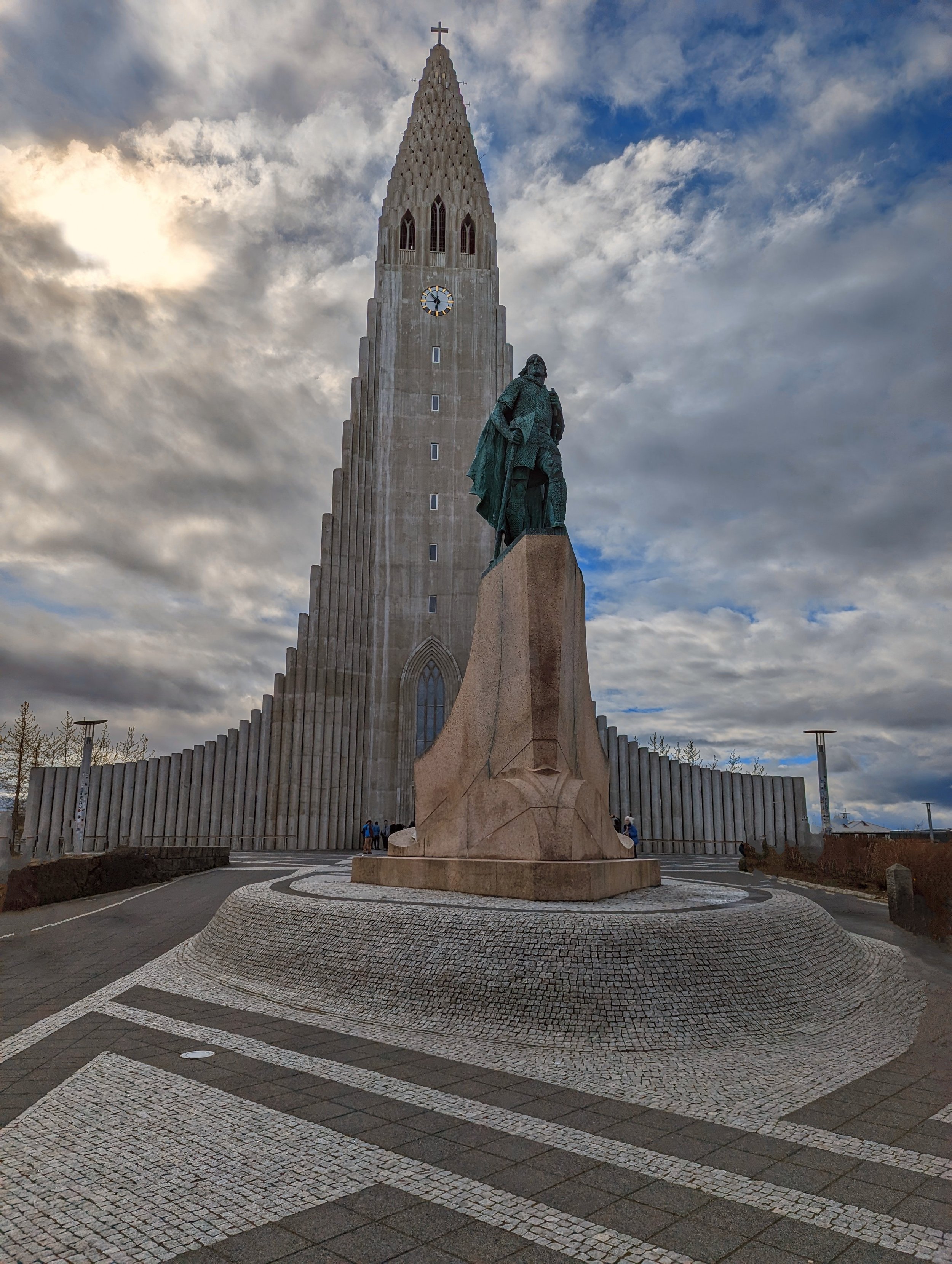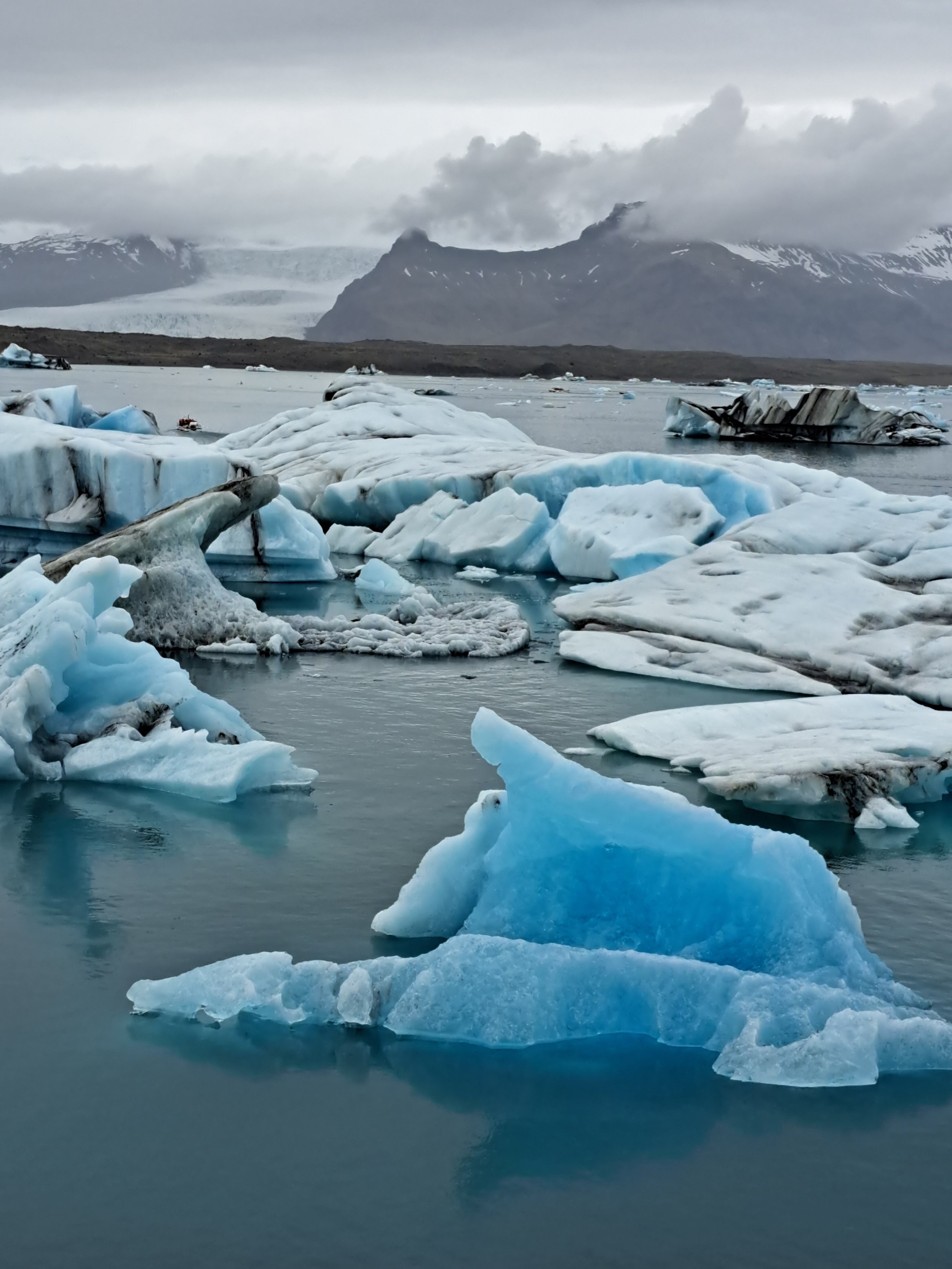10 Days of Iceland - Travel Blog
I share with you, the experiences had and sights seen on my 10-Day trip to Iceland.
DAY 1
Captivated by Iceland's architectural marvels, the towering Lutheran church commands the skyline. While the Blue Lagoon beckoned, my camera spared the bathing suit moment. In hindsight, a clever disguise with a silica mud mask from the Mask Bar could've been an option. Oh well, there's always a next time
DAY 2
May 7, 2023, Snæfellsnes Peninsula
Photo: Snæfelljökull Glacier
Under a clear sky, I reveled in the mesmerizing sight of a magnificently sculpted stratovolcano, reminiscent of Jules Verne’sJourney to the Center of the Earth, where magic thrives. The awe-inspiring landscape humbled me, emphasizing our minuscule existence amidst its vastness.
DAY 3
May 8, Akureyri, cultural capital of the North
Photo: Red Wheelbarrow at the entrance of the Botanical Gardens
At the head of a picturesque fjord, Akureyri stands tall, tracing its roots back to 1602 as a bustling trading center. As I wandered through the streets, the majestic timber buildings exuded a timeless glory, reminding me of the town's rich history.
One spot stole my heart—the enchanting garden that showcased the diverse beauty of almost all Icelandic plants. It was as if e.e. cummings' poignant words came to life, teaching me the enduring lesson of why so much depends on a red wheelbarrow.
Day 4
May 9 Siglufjördur
Located about 25 miles from the Artic Circle, this town has a lovely bakery.
Siglufjörður is a hidden pearl nestled within the out-of-this-world landscapes of Iceland. In 1915, this picturesque fishing town thrived amidst towering mountains and the vastness of the sea, creating a captivating backdrop for its bustling harbor.
Back then, Siglufjörður was a vibrant fishing hub, and the scent of saltwater filled the air as fishing boats crowded the harbor. The hard work and resilience of its residents were the beating heart of this tight-knit community.
I visited the Herring Era Museum. Let's take a moment to honor the extraordinary women of the herring industry. The herring women, also known as “herring girls” or “herring lasses,” played a crucial role in the herring industry in Iceland and other North Atlantic countries during the early to mid-20th century.
Working side by side, their swift hands moved in perfect rhythm, to gut, fillet, and preserve the abundant herring catch, thus ensuring the success of the fish processing factories.
Enduring long hours in harsh coastal conditions, the herring women exemplified resilience and expertise. In a word: *Sprakkar.
*The word Sprakkar is a “nod” to Iceland’s Eliza Reid and her new book Secrets of the Sprakkar: Iceland's Extraordinary Women and How They Are Changing the World.
DAY 5
On the way to Egilsstadir
Our journey led us to the awe-inspiring Godafoss Waterfall, known as the "Waterfall of the Gods." Here, history and nature converge, echoing an important chapter in Iceland's story that unfolded in the year 1000. The grandeur of this waterfall stands as a testament to the choices that shaped the destiny of a nation.
As we ventured further, I tried my best to capture the breathtaking landscapes that surrounded us. The pseudo craters at Skútustadir stood as whimsical creations, reminding me of the forces of nature at play. Each curve and contour painted a vivid picture of Iceland's geological wonders.
But it was at Dimmuborgir, with its eerie lava formations, where a touch of magic seemed to linger. As I explored the area, I could swear I spotted a troll or an elf hiding behind one of the prominent rocks. According to the sagas, seeing an elf in a dream was considered a significant and often prophetic experience. It was believed that these encounters held symbolic meaning and could provide insight into the future or offer guidance.
In this land of folklore and legends, the juxtaposition of Iceland's rich history and mystical landscapes leaves a lasting impression. Every step taken unraveled a piece of the nation's past while igniting a sense of wonder and curiosity.
While my photography skills shooting waterfalls may fall short, I couldn't resist sharing the splendor of these natural wonders. Let your imagination wander, and envision the secrets whispered by the winds in our Icelandic adventure.
DAY 6
Iceland’s Eastfijords
Venturing through this remote region, my gaze was captivated by the awe-inspiring fjords and majestic mountains that defined the landscape. But amidst the breathtaking views, my heart yearned for a special sight: the graceful presence of reindeer.
Reindeer, known as "hreindýr" in Icelandic, hold a unique place in Iceland's wildlife and cultural heritage. Surprisingly, they were not originally native to this land. Back in the late 18th century, the first reindeer were brought from Norway with hopes of establishing a new livelihood for Icelandic farmers. However, their integration into domestic herds didn't go as planned, leading to their release into the wild.
Today, the Eastfjords proudly harbor the largest population of wild reindeer in Iceland. These resilient creatures have skillfully adapted to the harsh Icelandic environment, showcasing their ability to withstand extreme weather conditions, from icy winds to bone-chilling temperatures. Nourishing themselves with mosses, lichens, and other vegetation, they thrive in the rugged and sparsely vegetated landscapes of the Icelandic highlands.
Reindeer have evolved to be more than just wildlife in Iceland; they embody the untamed spirit of the wilderness and the captivating beauty of the country's landscapes. They hold a significant place in Icelandic culture and folklore, symbolizing the enchantment and mystery of the natural world. Witnessing their majestic antlers and graceful movements as they traverse the snow-covered terrain during the winter months adds an extra touch of magic to an already mesmerizing atmosphere.
As I continued my exploration, the anticipation of encountering these remarkable creatures heightened my sense of wonder. Each step brought me closer to the possibility of a truly magical rendezvous with Iceland's reindeer, reminding me of the untamed beauty that awaits in the heart of the wilderness. It's worth noting that both male and female reindeer boast majestic antlers, bestowing upon the females an extraordinary status in the animal kingdom. It would be no exaggeration to say they too hold the secrets of the sprakkar.
DAY 7
From a Glacier to a Lagoon to a National Park, all in day’s journey
In the pause I beheld the grandeur of Vatnajökull Glacier, a magnificent marvel that took shape thousands of years ago. It conceals several active volcanoes beneath its icy surface—talk about an awe-inspiring combination! 😮❄️
But let me tell you, the true highlight of this icy wonderland was its enchanting lagoon.
As we ventured through the majestic Vatnajökull Glacier, the largest glacier in Europe, we were spellbound by the breathtaking shades of blue that surrounded us. But what exactly creates this ethereal display?
The secret lies in the ice's unique structure and composition. Over centuries, as the snowfall accumulates and compacts, the weight and pressure squeeze out tiny air bubbles, leaving behind ice crystals that are incredibly dense and pure. These crystal structures scatter light in a way that predominantly reflects the blue wavelength, creating that stunning icy blue color that captures our imagination.
But that's not all. The presence of glacial ice results in the absorption of most other colors within the visible light spectrum, further enhancing the dominance of blue. It's like nature's very own optical masterpiece.
So, as we embarked on our boat ride through the Vatnajökull Glacier's lagoon, we were treated to a captivating venture through this ethereal blue ice. Every turn and twist revealed a new shade of blue, an ever-changing palette of serenity and wonder.
If that is not enough, on the edge of this majestic glacier lies Skaftafell National Park, adding another layer of beauty to this already incredible landscape. It's a place that ignites a sense of wonder within your soul.
Dare to hold the pause.
DAY 8
South Coast
In this remote corner of Iceland, waterfalls become more than just a sight to behold—they become storytellers, narrating tales of the land's resilience and raw power. Each waterfall carries its own distinct charm and leaves an indelible mark on your soul.
So, as we journeyed along the south coast of Iceland, the captivating remoteness of the landscapes and the symphony of waterfalls reminded me that if you have seen one waterfall, you have not seen them all. Each holds its own magic, its own secrets waiting to be discovered.
DAY 9
Leaving Hella for Reykjavík
In the morning, we visited Gullfoss waterfall. Gullfoss, meaning "Golden Falls," lives up to its name with its cascading beauty and sheer power. As we approached, the thundering sound of rushing water grew louder, building anticipation for the sight that awaited us.
The waterfall plummeted dramatically in two stages, creating a mesmerizing spectacle.
Then we were off to the volcanic rift at the Strokkur Geyser. Reminiscent of the famous Old Faithful, this Icelandic gem showcased its own unique flair, erupting in a fiery display every ten minutes.
Next a visit to a farm of Icelandic horses to see the show of its distinctive five gaits, including its famous tölt. The sagas depict horses as valuable assets, representing wealth and social status. They were essential for transportation, enabling journeys across the vast and challenging Icelandic landscapes. The sagas also highlight the bond between humans and horses, emphasizing the deep connection and mutual dependence between them.
In the land of fire and ice, we stumbled upon a culinary delight that took my taste buds on an unforgettable journey. Behold, the humble tomato, but oh, how it transformed into a heavenly delight thanks to the magical touch of geothermal energy.
Within the enchanting greenhouses, nurtured by the warmth and light provided by the Earth itself, I was offered a little ripe tomato and indulged in its juicy sweetness. It was an explosion of flavor, a burst of freshness that transported me to a state of pure bliss.
But that was just the beginning. In a quaint little restaurant inside a greenhouse, I delved into a bowl of tomato soup that forever altered my perception of this humble fruit. The rich, velvety texture danced on my palate, each spoonful a symphony of taste and aroma. Paired with a hunky crust of bread, it was a match made in gastronomic heaven.
Iceland is my tomato paradise 🍅
DAY 10
UNESCO World Heritage site; Þingvellir National Park, Back to Rhetoric
In the heart of Iceland, I found myself in a place of profound geological significance - Þingvellir National Park. Here, I stood on the very edge of North America, witnessing a remarkable spectacle that left me in awe of the Earth's transformative power.
Þingvellir National Park sits at the meeting point of the Eurasian and North American tectonic plates, where the Earth's crust is tearing itself apart. It is a living testament to the ongoing process of continental drift.
The sight before me was a visual representation of the forces shaping our planet. Deep canyons and majestic rifts exposed the raw power of the Earth's movements, reminding me of the constant evolution occurring beneath our feet.
Walking through this geological wonderland, I marveled at the sheer magnitude of nature's forces. It was as if I could glimpse the very essence of our planet, witnessing the birth of new land and the ever-expanding chasm that separates the continents.
Nestled amidst the breathtaking landscapes of Iceland, Þingvellir National Park is a place where the marvels of nature intertwine with a rich tapestry of history and culture. Here, I stood on the hallowed ground where Iceland's first parliament, the Alþingi, was established in the year 930, forging a path as one of the oldest democratic institutions in the world.
As I gazed upon the expansive vistas, I couldn't help but ponder the ancient art of rhetoric, the very system that enabled the parliament to flourish. The plains of Þingvellir were more than just a physical gathering place; they were a crucible of ideas and debate, where Iceland's people came together to shape their destiny through words and discourse.
It was a testament to the power of rhetoric, the ability to sway opinions, and the art of effective communication. Regardless of the specific rhetoric that permeated Iceland's cultural fabric, it served as a means to foster dialogue, understanding, and collective decision-making.
Þingvellir National Park stands as a powerful reminder that the forces of nature not only shape the physical landscape but also leave an indelible mark on the stories and cultures that emerge from it. The rifts in the Earth's crust, visible and ever-expanding, mirrored the dynamic nature of democratic institutions, constantly evolving and adapting to the changing tides of time.
Standing on the edge of North America, I couldn't help but feel a deep appreciation for the interconnectedness of nature, history, and human aspirations. Þingvellir National Park encapsulated the essence of Iceland's democratic spirit, a testament to the resilience and ingenuity of its people.









